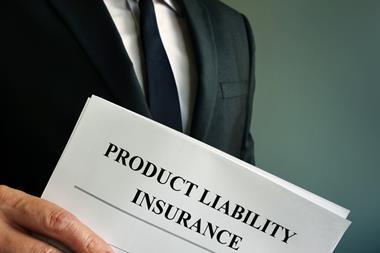Why captives have been used successfully as a form of insurance, and will likely continue to be. Claudia De Meulemeester reports

In today’s hyperconnected world, corporates are consolidating efforts and increasingly taking risks in their own hands. Most Fortune 500 and FTSE 250 companies have established risk management tools that alter the dynamics of traditional insurance relationships – with smaller and medium-sized enterprises increasingly aiming to do the same.
The notion of corporate self-insurance was first put into practice by Frederic Reiss in Bermuda in the 1960s. He introduced the term “captive” in the insurance industry, and put Bermuda on its course to become the leading captive domicile it is today. Since then, captives have been used by companies and conglomerates worldwide in several ways and for several reasons.
How does it work?
Captives, companies that insure the risks of their owners, have arguably filled a vacuum left by the regulated commercial insurance players.
“Risk management is evolving and is now being looked at through a different lens. Why pay the commercial market a blanket premium if we can do it ourselves via a captive company? An advantage is that frequent claims can easily be predicted, and captives also create a new revenue stream for the parent company,” argues Jereme Ramsay, business development manager for the risk sector at Bermuda’s Business Development Agency.
The captive receives premiums on a regular basis from the parent company that owns it, rather than paying a commercial insurer to insure a specific risk. By doing so the parent company de facto puts its own capital at stake and creates its own insurance company, which is usually based in a low-tax jurisdiction.
This can have a number of benefits.
The company is in full control of the funds used, and in charge of the captive’s profitability. By working outside the regulated insurance marketplace, the captive might create tax savings, be more cost-efficient, and improve cashflow. The risk financing mechanism of captives is especially beneficial to large corporations that may struggle to find the insurance covers they want in the traditional market or who believe the captive structure offers broader and better value coverage for the company’s needs.
“The owner is the beneficiary of the policy: this is a unique risk structure,” says Sarah Goddard, former CEO of Dublin’s International Insurance and Management Association (DIMA). “You will know your own risks better than anybody else,” she adds.
David Provost, deputy commissioner of the Captive Insurance State of Vermont, is on the same page. Vermont is one of the few US states that has created the legislative framework to encourage the formation of captives. (Other states such as Arizona and Tennessee are also increasingly setting up captives but Vermont is the traditional player.)
“Every business that you deal with, every product that you touch on a daily basis; that company uses a captive. It is a very attractive business,” says Provost.
Where is the business?
There are roughly 6,000 active captives around the world, of which two thirds are US-owned. Large US companies are considered by far the most advanced in the use of captives, but saturation is also changing the market.
European and other emerging markets are becoming more receptive to investing in the alternative risk transfer market, although the main business is still to be found in North America.
Non-US companies are increasingly looking at setting up captives in Bermuda, Ramsay tells StrategicRISK. “Canadian companies are becoming more prominent in the captive insurance space than previously, especially in the energy sector,” he says.
“Companies based in Latin American countries such as Mexico, Colombia, Chili, Peru and Argentina are showing interest in the process of forming a Bermuda-based captive,” Ramsay adds.
One major absentee thus far seems to be Asia’s market, where the risk transfer business for captives is less developed.
“The region has big companies that historically don’t have captives but want captives. Why wouldn’t some of the Chinese companies use captive models for their international business if most Fortune 500 and FTSE 100 do so? Their business models would benefit from this,” argues Michael Ashton, senior executive at Gibraltar Finance.
Not only geographical diversification but also capital diversification is observable in the captives business. Apart from “pure captives” (which are fully owned by their parent companies), so-called “sponsored captives” are increasingly being used by smaller companies lacking the means and capital to set up their own separate captive.
In this insurance model, the captive is managed and owned by a third party which provides core capital to set up the business. Smaller companies can then decide to contribute to the scheme while maintaining legally separate underwriting accounts, meaning that the assets in one contributor’s account may not be used to pay the liabilities of another firm.
Among European companies, sponsored captives have become more popular in recent years, in part due to appropriate EU legislation, StrategicRISK sources confirm.
“The times in which a company gives the insurance company a million dollars and the insurance company takes care of everything… that model is gone,” says Provost. “But there is a relationship of working together, in which both sides make a reasonable profit,” he adds.
What about regulation?
One of the issues that arise when working outside regulated insurance markets is the evident lack of a common regulatory framework. By using their own risk capital, companies using captives accept to renounce any state guarantee funds that commercial insurers could rely on – in the case of catastrophic claims, for example, if things go terribly wrong. That said, a captive can still choose to buy reinsurance covers to transfer risk in the same way the insurance market reinsures itself.
“As standalone companies they are pretty much masters of their own destiny within regulatory boundaries,” says Ian-Edward Stafrace, chief risk officer at Atlas insurance PCC in Malta.
The International Association of Insurance Supervisors (IAIS), based in Basel, has tried to develop global standards for the captives industry, but none of their recommendations is binding among the regulators of captives hub jurisdictions.
“There is no global framework to rely on,” notes Goddard, former chief executive of DIMA. “What we have at the moment as far as regulation is concerned is Solvency II in Europe and equivalents of those in other jurisdictions,” she adds.
Under Solvency II the EU Commission recognised captives as proper risk management tools and established by law the amount of capital EU insurance companies, including captives domiciled in EU territory, must hold to reduce the risk of bankruptcy.
The solvency capital mandated under the Solvency II framework is much higher than that required within some offshore jurisdictions, such as Bermuda, the Cayman Islands or Guernsey. Regulatory arbitrage naturally arises, leading to some switching between jurisdictions.
Another piece of regulation that is heavily scrutinised by the captive industry is BEPS (Base Erosion and Profit Shifting). Introduced by the Organisation for Economic Co-operation and Development (OECD) a multinational anti-corruption watchdog, BEPS refers to tax avoidance strategies which exploit gaps and mismatches in tax rules to artificially shift profits to low or no-tax locations where there is little or no economic activity, thus levering down the overall rate of corporate tax paid.
All sources speaking to StrategicRISK admitted captives sometimes suffer from a negative reputation outside the industry, but argue that tax avoidance as a strategic driver for captives is the exception and not the rule.
“BEPS is only going to affect a very few companies that have multinational captives. Some multinationals consolidate their business into once central captive, from smaller captives around the world. That’s where BEPS comes in. Is your pricing appropriate or are you artificially moving extra money to lower tax jurisdictions?” comments Provost.
Goddard agrees about the solid rationale behind the concept: “Captives are not some sort of dodgy type device that people use to hide money. They actually have got a good rational to be around and about.”
Despite Solvency II, sources do not expect captives to become much more intrusively regulated on a global scale. “A global standard wouldn’t necessarily be sufficiently sophisticated to react to the different views and types of risks that organisations want to put into a captive. Every captive is different. They are a bit like snowflakes, with different sizes as well,” concludes Goddard.
Safety and secrecy
The benefits of captive models for corporate risk management might seem clear, but the risks are less so. Is it as safe as commercial insurance?
“It is a matter of what you transfer and what you retain,” says Provost. “If you have a pretty good predictability of your environment, that is risk that you might as well retain. You want to transfer the earthquake and the hurricane. You don’t want to retain the risk of being wiped out by that. Safety is still there. You are just doing it more economically with a captive.”
Captives are usually set up and calculated for a very specific risk class or category. Property and casualty risks are predominantly used in captives because they are easier to quantify. There are captives that focus on cyber risk, terrorism or environmental risk, as well, but only very few.
“Captives have always been a very tailored product. They have a different sort of rationale than traditional insurance. That rationale can change depending on the market and depending on the risk,” says Goddard.
So has there been a case of a captive that has had liquidity problems or gone bankrupt?
Most captives around are pure captives, which means they are wholly-owned by the parent company. If something goes wrong or there has been mismanagement, it usually stays inside the company and it is therefore very rare for it to hit the news.
However, one case did hit the news a few years back.
When BP suffered its Deepwater Horizon oil spill disaster in the Gulf of Mexico, it relied on a Guernsey-based captive called Jupiter Insurance, of which it could receive $700m. BP’s actual bill after the environmental disaster was assessed ran into billions of dollars.
Did they miscalculate the risks or were they too big to fail?
“It is very difficult with companies like BP because their balance sheet is up in the billions, which means they are bigger than any insurance company,” argues Provost. “Why would they pay an insurance company to transfer the risk when BP can handle it themselves?”
In the end the money was still there to pay the claims. It just did not come from the captive it was originally assigned to rely on.
Brexit, Gibraltar & Malta
Brexit is – if not complicating things – at least making them more uncertain. That also goes for captives jurisdictions.
Since the inception of Solvency II, only two European jurisdictions have received approval to establish Protected Cell Companies (PCCs).
Gibraltar and Malta are the only European captive domiciles offering this form of insurance.
PCCs are a type of sponsored captives regulated by the EU that to be compliant require less administration costs, less time management and most importantly less solvency capital.
The minimum solvency capital for pure captives under Solvency II is €3.7m.
“The cost of implementing a pure captive under Solvency II regime is one where you have to make sure you did a very strong cost-benefit analysis before you went down that road,” observes Goddard.
PCCs form an alternative solution for EU companies who want to make use of the captive model but do not reach the capital benchmark.
“There was hardly any knowledge about cells in continental Europe ten years ago,” says Stafrace, who is based in Malta. “Solvency II has helped us enormously to promote cells and we see a reduction in standalone companies in favour of a shift towards more cell formations.”
Moreover, due to EU regulation, cell investments are protected and guaranteed by law which makes it an overall safer and more attractive investment. “Cells provide access to medium-size companies that would otherwise have to go offshore”, continues Stafrace.
The only issue with PCC, notes Stafrace, is that the risk portfolio is heavily dependent on the control and appetite of the core owner. The sponsor might not want to take up some form of risk that cell contributors want to insure against.
Although Gibraltar is also allowed to establish PCCs, it mostly attracts a smaller number of large pure captives, confirms Ashton, senior executive at Gibraltar Finance.
He continues: “Malta has been our main competitor in the past ten years but, after the referendum, less so. We have taken a different path. Maybe we were not as successful with Europe as we thought. Over 90% of the financial services business in Gibraltar is with the UK.”
Therefore, it makes sense for Gibraltar to stay as close as possible to the UK and vice-versa.
Stafrace, in Malta, agrees with the assessment: “Our more recent cells are from the Netherlands, Austria, Italy, and that was already the case pre-Brexit. We are seeing much more business from continental Europe than before and indicators show it will continue to be so.”
The relationship between the two jurisdictions can also be complementary when going through Brexit and advising clients on the changes ahead. “There are challenges and opportunities for both Malta and Gibraltar,” Stafrace concludes. “Before they would knock on both our doors. Now, if it the risks are predominantly European they might only come knock at the Maltese door and if British they might only knock on Gibraltar’s door.”
By Claudia De Meulemeester




















No comments yet